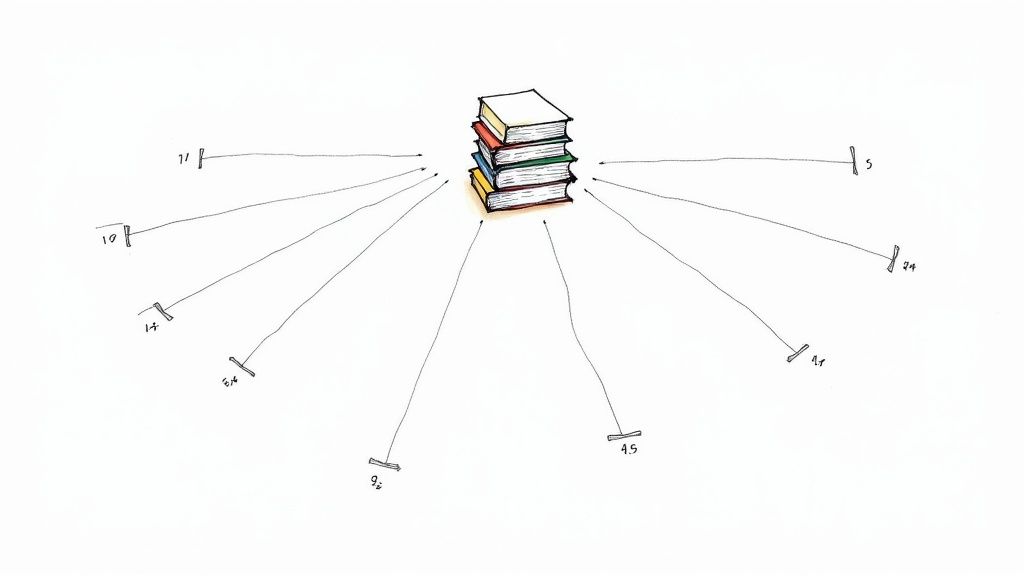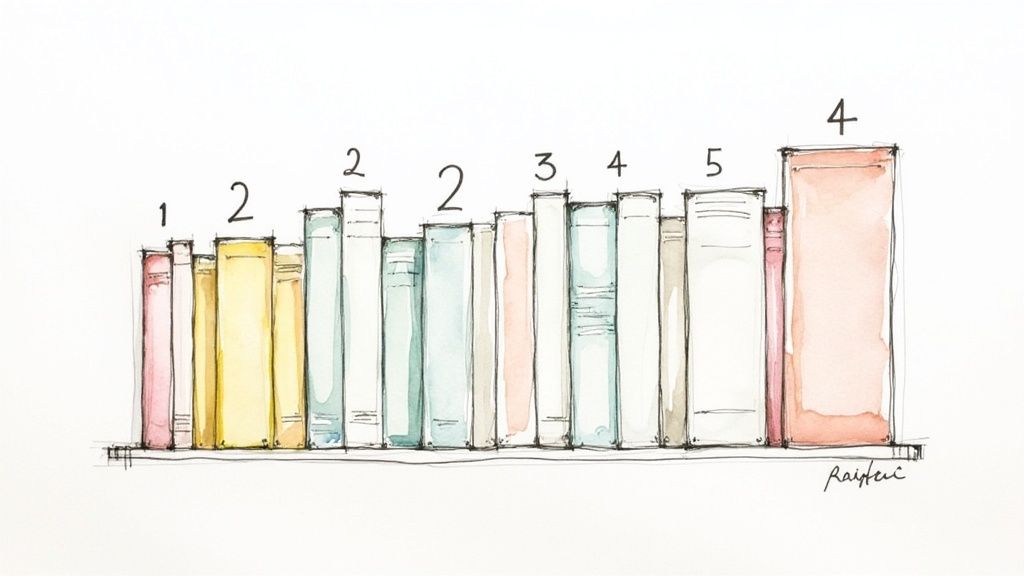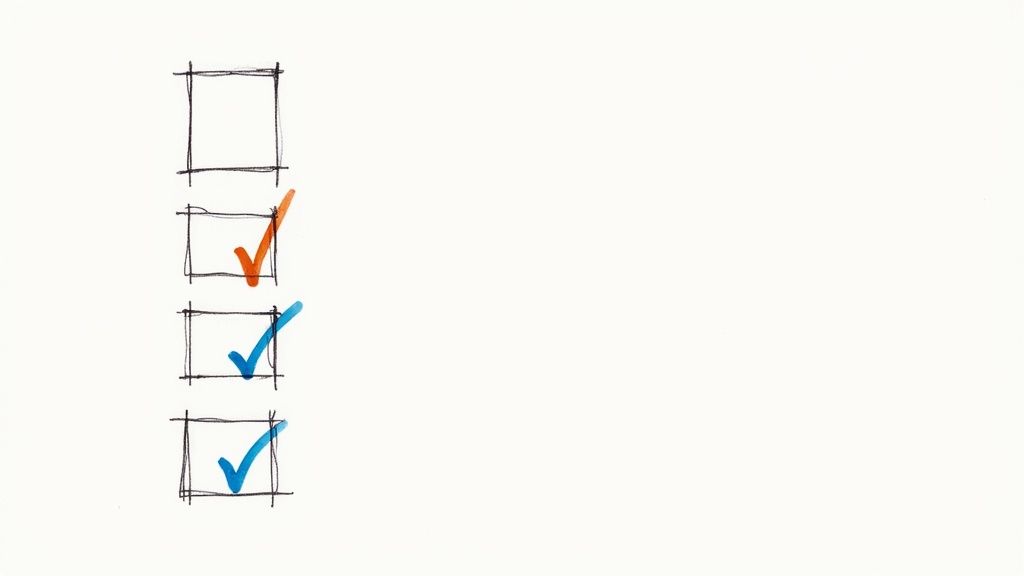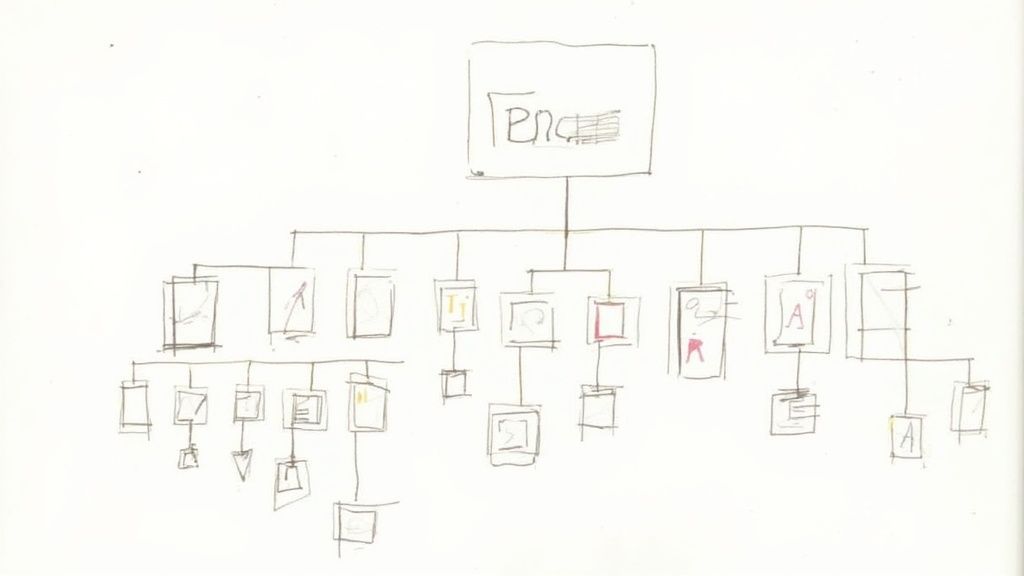Reading a book series in order is the only way to get the full story the author wanted to tell. When you jump in halfway through, you spoil the big reveals and miss out on the careful, deliberate way characters and their world come to life. It’s like turning a captivating journey into a confusing mess.
Why the Correct Order Is Everything
Imagine trying to put together a puzzle with half the pieces missing. You might get a vague idea of the final picture, but all the nuance, the clever connections, and the satisfaction of seeing it all come together are completely lost. That’s what it's like to read a series out of order.
Following the author's intended sequence isn't just about avoiding spoilers—it's about respecting the architecture of the story. Think of it like a grand symphony. Each book is a movement, building on the last to create a richer, more powerful emotional experience.
You'll Actually Watch the Characters Grow
One of the best parts of any great series is watching the characters evolve. A hero might start out clumsy and unsure of themself, but over several books, they transform into a confident leader. That growth only feels real and earned when you’ve been there for every step of their journey.
If you read out of order, you meet these characters after they've already changed, missing the key moments that defined who they became.
You wouldn't skip to the final season of a TV show and expect to understand the main character, right? It's the same idea. Every book adds a new layer to their personality, their struggles, and their triumphs.
You'll Witness the World Unfold Naturally
Authors of big, sprawling sagas build their worlds piece by piece, introducing new places, cultures, and rules over time. This slow reveal is a huge part of the fun. A tiny detail that seems insignificant in book one might become the key to everything in book four.
Reading your book series in order ensures you catch these clever bits of foreshadowing and appreciate the full scope of the author's vision as it was meant to be seen. This is especially true in epic fantasy and sci-fi. Just look at the Harry Potter saga, which remains the best-selling book series of all time with over 600 million copies sold worldwide. Its success comes from a world that grows deeper and more complex with every installment—a journey that only makes sense if you start at the beginning. You can learn more about these incredible numbers with best-selling book series statistics on wordsrated.com.
You'll Avoid Ruining the Best Parts
Finally, and most obviously, you won’t spoil the story for yourself. Big plot twists—a shocking betrayal, a secret identity, the outcome of a massive battle—are designed to hit you with maximum impact at a specific moment.
When you read out of sequence, these moments lose all their power. The tension just fizzles out, and the emotional payoff the author worked so hard to build is gone. Following the proper order turns reading from a simple pastime into an unforgettable journey where every twist and turn lands with the weight it deserves.
Understanding the Different Reading Orders
Every book series has its own roadmap, but figuring out which path to follow can feel like a quest in itself. Do you read the books as they were released, or do you follow the story’s internal timeline? Tackling a book series in order first means choosing your method.

There are three main ways to approach a series, and each one offers a completely different reading experience. Getting a handle on these options is the first step to crafting your perfect literary journey.
Publication Order The Author's Original Path
Publication Order is the simplest and most common approach: you read the books in the sequence they were originally published. For your first time through any series, this is almost always the safest bet.
Authors build their stories with specific reveals and plot twists in mind. Reading in publication order guarantees you experience those moments exactly as intended, preserving the suspense and surprise that make a story so addictive. Think of it as watching a film director’s original cut—you get the story just as the creator first shared it with the world.
Chronological Order A Historical Journey
Chronological Order arranges the books according to the story’s internal timeline. This means you might start with a prequel published years after the main series, simply because it happens first in the world’s history.
This approach is fantastic for readers who want a linear, historical understanding of the world and its characters. It provides deep context and shows how past events directly influence the future. But it comes with a major risk: prequels often contain massive spoilers for the main series because they assume you already know what happens later.
A classic example is C.S. Lewis's The Chronicles of Narnia. Reading chronologically means starting with The Magician's Nephew, which explains the creation of Narnia. But reading in publication order starts with The Lion, the Witch and the Wardrobe, letting you preserve the magic and mystery of discovering Narnia right alongside the Pevensie children.
Author's Recommended Order The Creator's Guidance
Sometimes, an author provides their own suggested reading order, which might differ from both publication and chronological sequences. When you find this, you've struck gold. It's the ultimate insider’s guide.
An author’s recommendation often blends the best of both worlds. They can guide you through the main plot while strategically placing novellas or prequels where they’ll have the most impact—without spoiling major events. When an author gives you a map, you should seriously consider using it. You can explore a deeper analysis in our article comparing complete vs. publication order.
Expert Insight: Following the author’s recommended order is like having a personal tour guide through their literary universe. It often offers the most balanced and satisfying narrative experience, especially in complex worlds with tons of extra material.
Choosing Your Reading Path
To help you decide which path is right for your next series, here’s a direct comparison of the two most common methods. Each one offers a distinct journey through the same story.
| Aspect | Publication Order | Chronological Order |
|---|---|---|
| Experience | Preserves the original plot twists and character reveals exactly as the author intended. | Provides a linear, historical view of the story's timeline from beginning to end. |
| Best For | First-time readers who want to avoid spoilers and experience the story's natural magic. | Rereaders or those who value deep world-building and context over narrative surprise. |
| Potential Downsides | The story's timeline might jump around, especially if prequels were released later. | A high risk of spoilers for the main series, as prequels often assume prior knowledge. |
Ultimately, there is no single "correct" way to read a book series. The best approach comes down to your personal preference and what you want to get out of the story. Do you crave the thrill of original surprises, or do you prefer the clarity of a straightforward timeline? Your answer will determine which reading adventure is the right one for you.
How to Find the Correct Reading Order for Any Series
You’ve found your next great adventure, an epic series you can't wait to get lost in. But then comes the big question: where do you actually start? Finding the correct reading order can feel like solving a puzzle, especially when authors throw prequels, novellas, and short stories into the mix.
Don't worry. We've got a simple, step-by-step process that will give you a clear map for your journey. With these resources, you'll know the definitive sequence for any series, from mainstream bestsellers to hidden gems. You'll never have to guess again.

Start at the Source: Author and Publisher Websites
Your first and most trustworthy stop should always be the author's official website. Creators like Brandon Sanderson and Robin Hobb are fantastic at providing detailed information about their works, including official reading orders, right on their sites. After all, they’re the ultimate authority on how their stories are meant to be experienced.
If the author’s site doesn't have what you’re looking for, the publisher's page for the series is your next best bet. Publishers want to make it easy for new readers to get hooked, so you'll often find the books listed sequentially right on the series landing page. It's a quick and official way to confirm the publication order.
Lean on the Community
When official sources come up short, the vast, collective knowledge of the reading community has your back. Platforms built and maintained by millions of passionate fans have already charted these literary worlds for you.
Here are the most reliable community resources:
Goodreads: This is the powerhouse of book cataloging. Just search for any book in the series, and right below the title, you'll almost always see the series name as a hyperlink (e.g., "The Kingkiller Chronicle #1"). Clicking that link takes you to a dedicated page with every book, novella, and short story listed in perfect order.
Fan Wikis: For massive universes like The Witcher or Dune, dedicated fan wikis are indispensable. These sites are meticulously maintained by die-hard experts who often provide multiple reading orders (publication, chronological, etc.) with detailed explanations for each path.
Dedicated Book Tracking Sites: Websites designed specifically to help readers find the correct book series in order are another goldmine. You can check out our own comprehensive series list to find thousands of authors and their works cataloged for easy navigation.
A Step-by-Step Checklist for Finding Any Order
Feeling overwhelmed? Don't be. Just follow this simple, tiered process to find the correct reading order for your next series. Start with the most reliable sources and work your way down the list.
- Check the Author’s Official Website: Look for a "Books" or "Series" section. This is the gold standard.
- Visit the Publisher’s Website: Search for the series title. Publishers almost always list the books in their intended publication sequence.
- Search on Goodreads: Find any book in the series and click the hyperlinked series title for a complete, ordered list.
- Consult a Fan Wiki: For complex series with extensive lore, a dedicated wiki is your best friend for detailed reading paths.
This methodical approach takes all the guesswork out of the equation. It's a reliable strategy that works for any genre, whether you're diving into a sprawling fantasy epic or a thrilling mystery series. In a global book market valued at Just when you think you’ve got the main book series in order, you stumble upon a whole universe of extra content. Prequels digging into the past, novellas filling in crucial gaps, and spinoffs following beloved side characters—it can feel like unlocking bonus levels in your favorite video game. But it also brings up a big question: where the heck do they fit in? Weaving these stories into your reading plan without wrecking the main narrative's flow is a bit of an art. Each type of extra story serves a different purpose, and knowing what that is helps you decide when to read it for maximum enjoyment—and minimal spoilers. A prequel is a story that takes place before the events of the main series. Authors write them to flesh out the world's history, reveal a character’s tragic backstory, or show a legendary event that was only hinted at in the core books. The big debate is always whether to read them first for context or later to preserve the mystery. Take George R. R. Martin’s A Knight of the Seven Kingdoms, a collection of novellas set a century before A Game of Thrones. Reading it first gives you a rich understanding of Westerosi history, but it also subtly spoils the fate of certain noble houses. General Rule of Thumb: For a first-time read, it’s almost always best to read prequels after you've finished the main series, or at least after the first few core books. Authors write them assuming you already have knowledge from the main plot, and they often contain foreshadowing that only makes sense in hindsight. Novellas and short stories are the connective tissue of a literary universe. These shorter works often explore a specific character’s side adventure or fill in a time gap between two major books. For example, The Expanse series by James S. A. Corey has several novellas that give you crucial background on key players. So where do they go? Publication order is usually your safest bet. Authors typically release these stories at specific points for a reason, often to provide context for the next book in the series. Squeezing a novella in between the main installments can seriously enrich the primary story. Understanding how to structure this kind of reading journey is key, and you can get more details in our guide to the chronological order of books. A spinoff is a whole new series set in the same universe but focused on different characters or a different part of the world. These are designed to stand on their own, but they're way more rewarding if you've already read the original series. They build upon the established lore, rules, and history. To integrate all these extra stories seamlessly, here are a few tips: Check Publication Dates: This is your most reliable tool. Reading everything in the order it was released is the best way to avoid spoilers and experience the world as it was built. Look for Author Recommendations: Many authors, like Brandon Sanderson, provide official reading order charts on their websites that show you exactly where to place every piece of supplemental material. Use Community Wisdom: Fan wikis and Goodreads series pages are treasure troves of information, often featuring detailed discussions on the ideal placement of each short story or prequel. Ultimately, these extra stories are meant to make your experience better, not more complicated. By strategically placing them on your reading list, you can turn a great series into an even deeper, more immersive world. In the age of sprawling literary universes, keeping track of every book, novella, and prequel can feel like a full-time job. Thankfully, you don't need a spreadsheet to manage your reading anymore. Modern tech offers a perfect solution, turning what could be a chore into a seamless part of the fun. Think of digital tools as your personal librarian. Websites and apps like Goodreads, The StoryGraph, and Serial Reader are built to help you manage your ever-growing reading list and follow any book series in order with absolute precision. One of the most practical perks of these platforms is the virtual bookshelf. Instead of a messy pile of sticky notes, you can sort books into clean, clear categories like "Want to Read," "Currently Reading," and "Read." It's incredibly simple but surprisingly powerful. Say you're starting a long fantasy saga. Just add the entire series to your "Want to Read" shelf. As you finish each book, you just move it over to "Read." Your progress updates automatically, and you can see exactly which installment comes next. All the guesswork is gone. Digital tracking tools don’t just organize your reading—they enhance it. By automating the process of following a series, they free up your mental energy to focus on what truly matters: getting lost in the story. This shift toward digital organization reflects what’s happening in the wider market. The global online books scene is projected to hit Navigating Prequels, Novellas, and Spinoffs

What Is a Prequel and When Should You Read It?
Fitting in Novellas and Short Stories
Understanding the Role of Spinoffs
Using Digital Tools to Track Your Reading Progress

The Power of Virtual Bookshelves
More Than Just a List
But these tools offer far more than simple organization; they foster a real sense of community. You can check out reviews from friends, jump into discussions about wild plot twists, and get great recommendations based on the series you already love.
Here are a few features that make the experience so smooth:
Progress Tracking: Log how far you are by page number or percentage. It’s a great motivator to see how far you've come and how much is left.
Automated Series Ordering: Most platforms automatically list series in the correct publication order, making it a breeze to know what to grab next.
Community Reviews: Read spoiler-free reviews from fellow readers to decide if a series is the right fit for you before you commit.
For readers who find staying organized a challenge, exploring some of the best ADHD productivity apps can offer some creative solutions for managing your reading lists, too. Ultimately, these digital aids can completely change how you interact with books, making it easier than ever to confidently tackle even the most massive series, like the many fantastic titles found in popular adult book series.
Your Next Great Literary Adventure Awaits
With a clear roadmap in hand, you’re ready to tackle any literary universe with confidence. The journey through a multi-book saga is one of the most rewarding experiences a reader can have, but it all starts with knowing which path to take.
Understanding how to find and follow your chosen book series in order is the key that unlocks the entire world just as the author imagined it.
The methods are simple but powerful. Publication Order lets you experience the story just as it was first revealed, keeping every twist and turn intact. Chronological Order offers a linear, historical view, perfect for digging into the deep lore of a complex world. And if you can find it, the Author's Recommended Order is a priceless guide straight from the creator themselves.
Empowering Your Reading Journey
Choosing the right path isn’t a test; it’s all about tailoring the adventure to your personal style.
For first-time readers, sticking to the publication sequence is almost always the best way to dodge spoilers and appreciate the intended narrative flow. For seasoned fans rereading a beloved series, a chronological approach can reveal new layers of depth and connection you might have missed before.
The goal is to feel empowered, not overwhelmed. With tools like author websites, community hubs like Goodreads, and dedicated fan wikis at your fingertips, you can quickly map out any series and dive in without hesitation.
This knowledge transforms you from a passive reader into a skilled navigator of story. You can now confidently step into sprawling epics from authors like Brandon Sanderson or Robin Hobb, knowing you have the tools to experience their work to the fullest.
You won’t just be reading books; you'll be undertaking a grand, coherent adventure from the first page to the very last.
Now, we invite you to keep the conversation going. Share your favorite series and the reading order you followed in the comments below. Let's build a community of passionate readers ready to explore new worlds together.
Frequently Asked Questions
Even the most seasoned readers run into a few tricky spots when navigating the complex worlds authors create. When you’re trying to follow a book series in order, some common questions pop up time and again. This section is here to give you clear, practical answers for those moments of confusion.
Think of this as your personal troubleshooter for any reading order challenge you might face, so you can get back to the story.
What Should I Do If I Accidentally Started a Series in the Middle?
Don't panic—it happens to the best of us. You grab a book, fall in love with the world and characters, and then discover you've jumped into book three of a seven-part epic. What you do next depends on the series and how much you hate spoilers.
If it's a plot-heavy series where every event builds on the last, your best bet is to stop, go find book one, and start over. This way, you get the full experience, from character introductions to the slow-burning plot twists, just as the author planned.
But what if you're too hooked to put it down? Just finish the book you're on. You can always circle back to the beginning afterward. You'll just have a little extra insight into where things are headed, which can be a fun and unique way to read a story. The main thing is to get the correct order sorted out from here on.
Is Publication Order Always the Best Way to Read a Series?
For a first-time reader, sticking to the publication order is almost always the safest and most rewarding path. You're getting the story exactly as the first fans did, with all the reveals and surprises intact. It’s the authentic, unfiltered experience.
But no, it’s not a one-size-fits-all rule.
For massive universes with sprawling histories and prequels, like Tolkien's Middle-earth, many readers find a chronological order more satisfying. Reading chronologically gives you a straight timeline of the world, from its creation myth to its greatest wars. The "best" way really comes down to the series itself and what you want to get out of it.
How Should I Handle a Series Continued by a New Author?
When a new writer takes the helm of a beloved series, it can feel a bit strange. This often happens with classic series when the original author's estate gives the green light for a continuation. The best way to handle this is to see the new books as a separate, but related, chapter of the universe.
Here's a simple game plan:
- Finish the original run first. Read every book by the original author, preferably in publication order. This lets you appreciate the creator's complete vision before anything else gets added.
- View the new books as a sequel series. After you've finished the original saga, you can decide if you're ready to see where the new author takes things.
- Go in with an open mind. A new author brings their own style to the table. It won't be exactly the same, but it can be a fantastic way to revisit a world you thought you’d left behind.
This approach honors the original work while letting you explore the expanded universe if you're still hungry for more. It keeps the two creative eras distinct, giving each the space it deserves.
At Books In Order, we do the heavy lifting so you don’t have to. Our database has accurate, easy-to-follow reading orders for thousands of series, letting you focus on what really matters—losing yourself in a great story. Find your next series and start reading the right way at https://booksinorder.org.
Tags: book series in order, reading order, chronological order, publication order, fantasy series